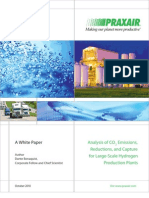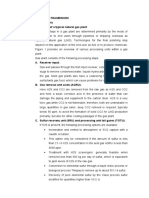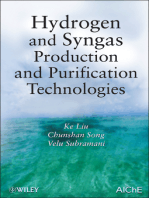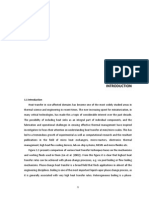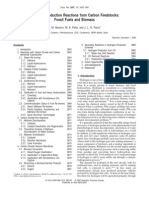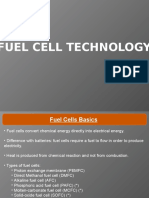Gasifying Coke To Produce Hydrogen in Refineries
Gasifying Coke To Produce Hydrogen in Refineries
Uploaded by
Atharva OfficeCopyright:
Available Formats
Gasifying Coke To Produce Hydrogen in Refineries
Gasifying Coke To Produce Hydrogen in Refineries
Uploaded by
Atharva OfficeOriginal Title
Copyright
Available Formats
Share this document
Did you find this document useful?
Is this content inappropriate?
Copyright:
Available Formats
Gasifying Coke To Produce Hydrogen in Refineries
Gasifying Coke To Produce Hydrogen in Refineries
Uploaded by
Atharva OfficeCopyright:
Available Formats
Gasifying coke to produce hydrogen
in refineries
Coke gasification to produce hydrogen for hydroprocessing is more capital intensive
than steam methane reforming, but not so vulnerable to natural gas price variations
Tek Sutikno and Kevin Turini
Fluor Enterprises
O
ne way a petroleum and to maximise the conversion • Gasifying coke from the exist-
refinery can meet the of heavy crude fractions to more ing or new coking unit to
hydrogen demand of valuable, lighter distillate prod- generate hydrogen.
hydroprocessing is to gasify ucts. The addition of Among these alternatives,
petroleum coke. It can be espe- hydrotreating or hydrocracking gasifying coke from the delayed
cially attractive to a refinery that units increases the hydrogen coker or a thermal cracking unit
includes a coking facility such demand of the refinery, and the is probably the least common
as a delayed or fluid coking unit thermal cracking units generate scheme implemented to date
producing petroleum coke. coke and other valuable distil- for expanding hydrogen gener-
Refineries have demanded more lates or light hydrocarbons. To ation. However, gasifying coke
hydrogen in the past two to meet the increased demand for to hydrogen can be an economi-
three decades as more extensive hydrogen, refinery managers cally attractive option for
hydroprocessing (hydrotreating often need to select a scheme or certain refineries given the
and hydrocracking) is required schemes for generating or favourable market conditions.
for the processing or upgrading supplying more hydrogen from Availability of coke and the
of heavy crudes and the removal a number of available alterna- price fluctuation of alternative
of sulphur and nitrogen to meet tives. These may vary from one raw materials should be consid-
the more stringent specifications refinery to another, but typically ered and evaluated before
of transportation fuels. include the following: finalising the selection of a new
To enable the processing of • Recovering hydrogen from hydrogen production scheme
heavier crudes to maximise refinery fuel gas for the refinery. This article
yields of valuable distillates or • Expanding existing catalytic presents an overview of coke
light hydrocarbons, some refin- reformer throughput to increase gasification for generating
eries have expanded their hydrogen generation, if availa- hydrogen in refineries and
complexity by adding an ble and viable, to meet the discusses design options for
upgrading unit such as a hydro- maximum benzene limit of optimally integrating the coke-
cracker, hydrotreater or a gasoline to-hydrogen plant within the
thermal cracking unit like a • Expanding the steam reform- refinery’s operation.
delayed coker, in addition to a ing unit (or hydrogen
fluid catalytic cracking (FCC) production unit), if available Hydrogen yield from coke
unit. All of these units enable • Installing a new steam reform- Gasification of coke or coal
the refinery to process heavier ing unit, which normally uses typically involves licensed
or more sour crude oils, which fuel gas or naphtha processes with different supple-
typically have a low cost advan- • Over the fence (OTF) hydro- mentary, reactant feed schemes
tage over the lighter crude oils, gen import and varying gasifying reaction
www.digitalrefining.com/article/1000550 PTQ Q3 2012 1
Air separation
unit (ASU)
Steam CO2 H2S 99% + H2
Oxygen
Air
(or oxygen)
Quenching Shift Acid gas Hydrogen
Coke or Gasification
coke slurry Cooling conversion removal unit purification
Steam or Scrubbing (AGRU) unit
water
Slag BFW/water
Figure 1 Coke gasification flow scheme to produce hydrogen
conditions. For example, air is CO and H2O to H2 and CO2 in Gasifying coke to hydrogen
fed directly to air-blown gasifi- the downstream shift reaction Obviously, cost competitiveness,
ers, while other gasifiers are unit. technological maturity and
fed with high-purity (about For a rough estimate at the operating reliability need to be
99.5%) oxygen from an air conceptual evaluation stage, evaluated when considering a
separation unit. Steam is also about 27 scf of hydrogen can gasification scheme. Another
fed directly to some dry feed be generated per pound of important aspect to evaluate is
gasifiers, while others are fed coke. While the amount of the optimal design integration
with coal or coke in a slurry coke a typical refinery could of the process units in the new
with water. Reaction conditions generate depends on a number coke gasification facilities with
typically vary in pressure from of factors, such as crude oil the existing or planned refinery
430 psig to about 1200 psig (30- characteristics, refining operation. Optimal integration
80 bar) and in reaction outlet schemes and others, a refinery will maximise the economic
temperature up to about 2700°F generates an approximate benefits from gasifying coke for
(1480°C). Product compositions average of 12.5 tons of coke hydrogen generation and
vary, depending upon the per 1000 barrels of crude oil. enhance the competitiveness of
selected gasification technology Coke yield varies, depending the overall refinery operation.
and the characteristics of the on crude properties such as Examples of integrating issues
petroleum coke. For the gasifi- Conradson carbon content, are discussed next.
cation of petroleum coke, the and generally increases as Figure 1 shows a typical flow
gasifier generally produces crude feed becomes heavier. scheme for gasifying coke to
syngas with typical H2-to-CO As an example, a 200 000 b/ produce hydrogen. Oxygen-
molar ratios of less than one. d refinery generates approxi- blown gasifiers are typically
CO2, H2O and CH4 are the mately 2500 t/d of petroleum required for generating hydro-
secondary product components coke that can be gasified, gen from coke. However, the
at lower concentrations relative generating approximately 135 air separation unit for separat-
to those of H2 or CO. In addi- MMscfd of hydrogen. If LPG ing oxygen from ambient air
tion, the syngas is contaminated is used to generate the hydro- constitutes a significant part of
with H2S, CO2, COS and other gen from the conventional the total capital cost. Air-blown
sulphur compounds. Raw steam reforming process, about gasifiers directly utilising
syngas from the gasifier can be 8000 b/d (excluding fuel oxygen in air generate syngas
cooled through a steam genera- requirement) of LPG would with high concentrations of
tion system or a quench and have been required as the raw nitrogen, and the resulting
scrubbing section, where the material, and steam reforming syngas is more suitable for
raw syngas becomes saturated requires a significant amount electricity generation using gas
with water at a target tempera- of fuel in addition to the raw turbines than for producing
ture adequate for converting materials. hydrogen.
2 PTQ Q3 2012 www.digitalrefining.com/article/1000550
For gasifiers where coke is free feed stream. An acid gas remove COS. Catalytic hydroly-
fed as a pumpable slurry, water removal unit upstream of the sis operation of COS can
instead of steam is fed to the sweet shift conversion unit will generally reduce COS content
gasifier. Water or steam serves be necessary to remove sulphur to typically less than 10 to 20
as a reactant to generate hydro- compounds in the syngas from ppmv.
gen and a quenching medium the gasifier, and another acid
for the gasifier. Syngas from the gas removal unit will also be Acid gas removal
gasifier requires cooling and needed downstream of the The acid gas content, mainly
scrubbing to remove particulate sweet shift conversion unit to CO2 and H2S, of syngas from
matter before entering the shift remove CO2. the shift conversion unit is
conversion unit, where CO Producing hydrogen from removed in the acid gas
reacts with H2O to produce H2 coke gasification syngas gener- removal unit, for which a
and CO2. ally involves two or more shift number of proprietary solvents
Similar to the conventional reaction stages in series — a high- and design schemes are availa-
hydrogen manufacturing proc- temperature shift converter and ble from several licensors. Due
ess via steam reforming, where a low-temperature shift to high CO2 concentrations in
design options with varying converter, followed by a metha- the acid gas removal unit feed
levels of steam generation are nation reactor hydrogenating gas, physical solvents instead of
available, some licensed gasifi- the residual CO to methane and chemical solvents can be consid-
ers may offer options for water, or a pressure swing ered for CO2 removal in coke
quenching or cooling the syngas adsorption unit to produce gasification plants.
with varying rates of steam high-purity, 99.9% hydrogen. The acid gas removal unit in
generation. These options may Low CO slip (high CO conver- coke gasification typically
need to be evaluated for proper sion to H2) requires a involves acid gas absorbers and
integration within the existing low-temperature shift converter solvent regenerators. The
refinery steam system or for and adequate steam-to-CO solvent regeneration system
planned enhancement of this ratios in the feed stream. A generates a CO2-rich gas stream
system. Steam from coke gasifi- higher rate of quench water and a H2S-rich stream. While
cation is typically used as a injected upstream will increase venting the CO2-rich stream
reactant in the downstream the steam-to-CO ratio of the directly to the atmosphere may
shift conversion unit, and excess feed stream to the shift conver- be allowed in certain geograph-
steam generated can be utilised sion unit, but decreases the net ical locations, compressing this
to reduce the fuel consumption amount of export steam that stream through a pipeline to
of the utility boiler, increase can be generated in the cooling reservoirs for enhanced oil
power generation or operate section of the syngas. It may be recovery or sequestration is
critical equipment items on necessary to work together with another disposal option. In
steam turbines for mitigating the gasifier licensor and shift certain geographic areas, there
the time-dependent flare relief catalyst supplier to specify a are tax credits for CO2 seques-
load of the refinery in the event steam system optimally inte- tration or a market for the use
of power failure. grated with the refinery. of CO2 in enhanced oil recovery
As syngas from coke gasifica- The bulk of the sulphur in the that can improve the economics
tion typically contains sulphur coke converts to H2S in the of gasification.
compounds, sour (or sulphur- gasifier, and the remainder The H2S-rich gas stream
resistant) shift catalysts are mainly to COS. A provision to from the acid gas removal unit
generally used in the shift hydrolyse COS to CO2 and H2S is sent to a sulphur recovery
conversion unit, operating in a may need to be included in the unit (SRU), converting H2S to
pre-sulphided condition for shift conversion unit. H2S is elemental sulphur, and this
converting essentially all of the easier to remove than COS in requires capacity expansion of
CO to CO2 and H2. Sweet shift the downstream acid gas the existing sulphur recovery
catalysts can also covert CO to removal unit, and not all facilities of the refinery.
hydrogen but require, among solvents available for an acid Oxygen enrichment of the SRU
others, an essentially sulphur- gas removal unit effectively is a cost-competitive option for
www.digitalrefining.com/article/1000550 PTQ Q3 2012 3
expanding the existing capac- hydrogen concentration before unit, which can be operated
ity. If this option remains entering the reactor. Generally, continuously up to five years
viable and can be considered, 97 vol% make-up hydrogen between major turnarounds, the
the oxygen generation capacity purity can be produced from coke gasifier typically requires
of the new air separation unit the acid gas removal unit a scheduled shutdown or turna-
may be increased to supply followed by a methanation unit round about once every two to
the oxygen demand required for converting the residual CO six months, and this require-
for capacity expansion of the and CO2 to methane and reduc- ment may vary from one
SRU. This integration of the ing the total carbon oxides level licensed unit to another. To
oxygen supply system may to less than 10 ppmv. A pres- improve the reliability and
reduce the capital cost of sure swing adsorption unit can availability of a coke gasifica-
generating hydrogen from increase the hydrogen purity to tion unit, spare gasifiers are
refinery coke. higher than 99.9 vol% at a typically installed; for example,
hydrogen recovery rate typically 2 x 100% or 3 x 50% gasifiers.
Hydrogen demand approaching 90%. It may be For the overall gasification unit,
Essentially all of the hydrogen worthwhile checking with the gasification and quench/
manufactured will be utilised hydroprocessing catalyst suppli- cooling sections have been
as make-up hydrogen in the ers about the economic benefit reported to cause higher
hydroprocessing units of the of higher hydrogen partial pres- percentages of unplanned shut-
refinery, and high-purity levels sures and comparing it with the downs relative to the remaining
of make-up hydrogen are costs associated with the higher sections.
desired. Hydroprocessing units purity make-up hydrogen.
include hydrotreating and Additionally, alternate process Conclusion
hydrocracking. Hydrotreating schemes are available to signifi- Compared to the conventional
units reduce the sulphur, nitro- cantly increase the hydrogen and common method of
gen, oxygen and metal partial pressure at the inlet of producing hydrogen from the
impurities in the refinery the hydroprocessing reactors steam reforming of light
streams to meet the allowable without relying on make-up hydrocarbons, gasifying coke
limits. Hydrogenation of olefins hydrogen purities higher than to produce hydrogen is gener-
and aromatics and hydrocrack- 97%. ally more capital intensive.
ing reactions may also take The hydroprocessing units of This results in a high percent-
place to a lesser extent. In the a typical refinery operate at age of capital recovery factor
extreme, ring saturation is different reaction pressure in the unit cost of hydrogen
targeted to increase distillate levels, which generally increase production from coke gasifica-
cetane. as the feeds become heavier, tion. On the other hand, about
Hydrocracking units convert and some licensors offer a range 70% or more of the unit hydro-
the feed stream to a lower boil- of gasifier operating pressures. gen production cost from a
ing range (lighter) product The different operating pres- steam methane reforming
through cracking and hydro- sures of the hydroprocessing process is the cost of purchas-
genation reactions. Sulphur and units and the required hydro- ing natural gas, which is
other impurities are also gen make-up rates will need to consumed as feedstock and
reduced in hydrocracking units. be reviewed to determine the fuel.
Higher partial pressures of optimal supply pressure of Depending upon the price
hydrogen in hydroprocessing hydrogen from the new coke difference between natural gas
reactions result in improved gasification plant to minimise (or other hydrocarbon feed-
reaction yields or longer catalyst the overall compression horse- stock) and coke, the unit
lifetimes. The purity of refinery power and the number of production cost of hydrogen
make-up hydrogen is generally compression stages. can reportedly be higher for
in the range 95 vol% to higher steam methane reforming
than 99.9 vol% and is typically Reliability and costs compared to coke gasification,
combined with the recycle gas Compared to other refinery especially when the natural gas
stream at about 82 to 85 vol% process units, such as the FCC price is on the high side of the
4 PTQ Q3 2012 www.digitalrefining.com/article/1000550
wide volatility range. For refin- Tek Sutikno is Process Engineering Links
eries with captive coke Manager with Fluor. He holds BSc,
More articles from: Fluor
production and also a need to MSc and DEngr degrees in chemical
import expensive natural gas, engineering and a MBA degree, all from More articles from the following
categories:
producing hydrogen from coke the University of Kansas.
gasification should be consid- Email: tek.sutikno@fluor.com Gasification
ered and would minimise the Kevin Turini is a Process Manager at Fluor Hydrogen Management
impact of natural gas price with over 13 years’ experience. He holds
volatility on the refinery’s over- a bachelor’s degree from the University
all profitability. of Texas at Austin.
www.digitalrefining.com/article/1000550 PTQ Q3 2012 5
You might also like
- Hydrogen Gas Production by Partial OxidaNo ratings yetHydrogen Gas Production by Partial Oxida69 pages
- Co-Processing Renewables in A HydrocrackerNo ratings yetCo-Processing Renewables in A Hydrocracker5 pages
- Integrated Catalytic Membrane Reactor For Hydrogen Production Using Hydrocarbon-Based FuelsNo ratings yetIntegrated Catalytic Membrane Reactor For Hydrogen Production Using Hydrocarbon-Based Fuels4 pages
- 1002635 DeGBPayed Coking as a SustainabGBPe Refinery SoGBPutionNo ratings yet1002635 DeGBPayed Coking as a SustainabGBPe Refinery SoGBPution6 pages
- New KBR Process For Coal To Ammonia: Kamal Gursahani, Siva Ariyapadi, Meghji Shah and Richard StraitNo ratings yetNew KBR Process For Coal To Ammonia: Kamal Gursahani, Siva Ariyapadi, Meghji Shah and Richard Strait12 pages
- Hydrogen Generation For Modern Refineries 2009No ratings yetHydrogen Generation For Modern Refineries 20097 pages
- Cracking, Visbreaking, Coking and PropertiesNo ratings yetCracking, Visbreaking, Coking and Properties12 pages
- Unit Processes Assignment: Made By:-Name:-E.Nithya CLASS:-B.TECH-2 ROLL NO:-U13CH039No ratings yetUnit Processes Assignment: Made By:-Name:-E.Nithya CLASS:-B.TECH-2 ROLL NO:-U13CH03939 pages
- Hydrogen Production by Steam Reforming of HC by Topsoe100% (1)Hydrogen Production by Steam Reforming of HC by Topsoe2 pages
- Hydrogen Production Steam Methane ReformingNo ratings yetHydrogen Production Steam Methane Reforming4 pages
- Control Strtegies For Flexible Operation of Power Plant Integrated With Co2 Capture PlantNo ratings yetControl Strtegies For Flexible Operation of Power Plant Integrated With Co2 Capture Plant6 pages
- Nitrogeoin Rejection Technology For Abu DhabiNo ratings yetNitrogeoin Rejection Technology For Abu Dhabi10 pages
- Simulation Analysis of Bio-Oil Reforming For Co-Production Syngas and High Purity H2 or CO2 With Chemical Looping ProcessesNo ratings yetSimulation Analysis of Bio-Oil Reforming For Co-Production Syngas and High Purity H2 or CO2 With Chemical Looping Processes11 pages
- Air Liquide 2022 Article On Off Gas Use in SMRNo ratings yetAir Liquide 2022 Article On Off Gas Use in SMR5 pages
- Integration of Gasification With Thermal Residue Conversion in RefineriesNo ratings yetIntegration of Gasification With Thermal Residue Conversion in Refineries15 pages
- Improving The Efficiency of A Chilled Ammonia CO2No ratings yetImproving The Efficiency of A Chilled Ammonia CO27 pages
- Potential For Hydrogen Generation From in Situ Combustion of Athabasca BitumenNo ratings yetPotential For Hydrogen Generation From in Situ Combustion of Athabasca Bitumen12 pages
- Praxair CO2EmissionsReductionCapture WhitepaperNo ratings yetPraxair CO2EmissionsReductionCapture Whitepaper10 pages
- United States Patent (10) Patent No.: US 8,118,895 B1No ratings yetUnited States Patent (10) Patent No.: US 8,118,895 B14 pages
- Selection of Technologies For Gas Plant NaturalNo ratings yetSelection of Technologies For Gas Plant Natural15 pages
- A New Approach To Fuel Cells Turns Wastewater Into Clean Water and ElectricityNo ratings yetA New Approach To Fuel Cells Turns Wastewater Into Clean Water and Electricity11 pages
- Encyclopaedia Britannica, 11th Edition, Volume 8, Slice 3 "Destructors" to "Diameter"From EverandEncyclopaedia Britannica, 11th Edition, Volume 8, Slice 3 "Destructors" to "Diameter"No ratings yet
- Synthetic Natural Gas: From Coal, Dry Biomass, and Power-to-Gas ApplicationsFrom EverandSynthetic Natural Gas: From Coal, Dry Biomass, and Power-to-Gas ApplicationsTilman J. SchildhauerNo ratings yet
- Cutting-Edge Technology for Carbon Capture, Utilization, and StorageFrom EverandCutting-Edge Technology for Carbon Capture, Utilization, and StorageKarine Ballerat-BusserollesNo ratings yet
- The Origins and Fates of Chlorides in Hydroprocessing Units: Part 1: Recognising The ProblemNo ratings yetThe Origins and Fates of Chlorides in Hydroprocessing Units: Part 1: Recognising The Problem8 pages
- 2017 03 28 Cosasco Corrosion and Erosion Monitoring Presentation ICorr Industrial VisitNo ratings yet2017 03 28 Cosasco Corrosion and Erosion Monitoring Presentation ICorr Industrial Visit80 pages
- Basf Transforming Refineries Opportunities Through FCCNo ratings yetBasf Transforming Refineries Opportunities Through FCC7 pages
- 12E4DF00000018.toc - RMC-17-24 Non-Intrusive Corrosion Monitoring - Christiane Lederer - PermasenseNo ratings yet12E4DF00000018.toc - RMC-17-24 Non-Intrusive Corrosion Monitoring - Christiane Lederer - Permasense17 pages
- Viscosity and Stability of Visbroken Fractionated OilsNo ratings yetViscosity and Stability of Visbroken Fractionated Oils210 pages
- Hydrogen GT Readiness White Paper OriginalNo ratings yetHydrogen GT Readiness White Paper Original25 pages
- Introduction To Microscale Heat TransferNo ratings yetIntroduction To Microscale Heat Transfer14 pages
- Thyssenkrupp Electrolytic Hydrogen Brochure100% (2)Thyssenkrupp Electrolytic Hydrogen Brochure5 pages
- Hydrogen Production in Chlamydomonas ReinhardtiiNo ratings yetHydrogen Production in Chlamydomonas Reinhardtii12 pages
- PDF (Ebook) Focus on Energy Management by Andrea M. Rocco; Joshua E. Levin ISBN 9781620818435, 1620818434 download100% (2)PDF (Ebook) Focus on Energy Management by Andrea M. Rocco; Joshua E. Levin ISBN 9781620818435, 1620818434 download55 pages
- 2024-09-09 Kochi_GH2_Valley Roadmap_IGEFNo ratings yet2024-09-09 Kochi_GH2_Valley Roadmap_IGEF268 pages
- Renewable and Sustainable Energy Reviews: Shabana P.S. Shaikh, Andanastuti Muchtar, Mahendra R. SomaluNo ratings yetRenewable and Sustainable Energy Reviews: Shabana P.S. Shaikh, Andanastuti Muchtar, Mahendra R. Somalu8 pages
- (Ebooks PDF) Download Green Energy To Sustainability Strategies For Global Industries 1st Edition Alain A. Vertes (Editor) Full Chapters100% (1)(Ebooks PDF) Download Green Energy To Sustainability Strategies For Global Industries 1st Edition Alain A. Vertes (Editor) Full Chapters54 pages
- Hydrogen Production Reactions From Carbon Feed Stocks Fossil Fuels and BiomassNo ratings yetHydrogen Production Reactions From Carbon Feed Stocks Fossil Fuels and Biomass40 pages
- Application of Biomass To Hydrogen and Syngas Production: Chemical EngineeringNo ratings yetApplication of Biomass To Hydrogen and Syngas Production: Chemical Engineering6 pages
- RenewablebiohydrogenproductionfromstrawNo ratings yetRenewablebiohydrogenproductionfromstraw15 pages
- IRENA - 2023 - Creating A Global Hydrogen MarketNo ratings yetIRENA - 2023 - Creating A Global Hydrogen Market46 pages
- Development of 70 Mpa Differential-Pressure Water Electrolysis Stack100% (1)Development of 70 Mpa Differential-Pressure Water Electrolysis Stack8 pages
- Hydrogen: The Future of Energy: Matters! Matters! Matters!No ratings yetHydrogen: The Future of Energy: Matters! Matters! Matters!1 page
- Daniela GOLEA, COZMA Lucian Ștefan - Ecological Fueling System For Vehicles Equipped With Combustion EnginesNo ratings yetDaniela GOLEA, COZMA Lucian Ștefan - Ecological Fueling System For Vehicles Equipped With Combustion Engines12 pages
- Integrated Catalytic Membrane Reactor For Hydrogen Production Using Hydrocarbon-Based FuelsIntegrated Catalytic Membrane Reactor For Hydrogen Production Using Hydrocarbon-Based Fuels
- 1002635 DeGBPayed Coking as a SustainabGBPe Refinery SoGBPution1002635 DeGBPayed Coking as a SustainabGBPe Refinery SoGBPution
- New KBR Process For Coal To Ammonia: Kamal Gursahani, Siva Ariyapadi, Meghji Shah and Richard StraitNew KBR Process For Coal To Ammonia: Kamal Gursahani, Siva Ariyapadi, Meghji Shah and Richard Strait
- Unit Processes Assignment: Made By:-Name:-E.Nithya CLASS:-B.TECH-2 ROLL NO:-U13CH039Unit Processes Assignment: Made By:-Name:-E.Nithya CLASS:-B.TECH-2 ROLL NO:-U13CH039
- Hydrogen Production by Steam Reforming of HC by TopsoeHydrogen Production by Steam Reforming of HC by Topsoe
- Control Strtegies For Flexible Operation of Power Plant Integrated With Co2 Capture PlantControl Strtegies For Flexible Operation of Power Plant Integrated With Co2 Capture Plant
- Simulation Analysis of Bio-Oil Reforming For Co-Production Syngas and High Purity H2 or CO2 With Chemical Looping ProcessesSimulation Analysis of Bio-Oil Reforming For Co-Production Syngas and High Purity H2 or CO2 With Chemical Looping Processes
- Integration of Gasification With Thermal Residue Conversion in RefineriesIntegration of Gasification With Thermal Residue Conversion in Refineries
- Potential For Hydrogen Generation From in Situ Combustion of Athabasca BitumenPotential For Hydrogen Generation From in Situ Combustion of Athabasca Bitumen
- United States Patent (10) Patent No.: US 8,118,895 B1United States Patent (10) Patent No.: US 8,118,895 B1
- A New Approach To Fuel Cells Turns Wastewater Into Clean Water and ElectricityA New Approach To Fuel Cells Turns Wastewater Into Clean Water and Electricity
- Encyclopaedia Britannica, 11th Edition, Volume 8, Slice 3 "Destructors" to "Diameter"From EverandEncyclopaedia Britannica, 11th Edition, Volume 8, Slice 3 "Destructors" to "Diameter"
- Synthetic Natural Gas: From Coal, Dry Biomass, and Power-to-Gas ApplicationsFrom EverandSynthetic Natural Gas: From Coal, Dry Biomass, and Power-to-Gas Applications
- Cutting-Edge Technology for Carbon Capture, Utilization, and StorageFrom EverandCutting-Edge Technology for Carbon Capture, Utilization, and Storage
- Hydrogen and Syngas Production and Purification TechnologiesFrom EverandHydrogen and Syngas Production and Purification Technologies
- The Origins and Fates of Chlorides in Hydroprocessing Units: Part 1: Recognising The ProblemThe Origins and Fates of Chlorides in Hydroprocessing Units: Part 1: Recognising The Problem
- 2017 03 28 Cosasco Corrosion and Erosion Monitoring Presentation ICorr Industrial Visit2017 03 28 Cosasco Corrosion and Erosion Monitoring Presentation ICorr Industrial Visit
- Basf Transforming Refineries Opportunities Through FCCBasf Transforming Refineries Opportunities Through FCC
- 12E4DF00000018.toc - RMC-17-24 Non-Intrusive Corrosion Monitoring - Christiane Lederer - Permasense12E4DF00000018.toc - RMC-17-24 Non-Intrusive Corrosion Monitoring - Christiane Lederer - Permasense
- Viscosity and Stability of Visbroken Fractionated OilsViscosity and Stability of Visbroken Fractionated Oils
- PDF (Ebook) Focus on Energy Management by Andrea M. Rocco; Joshua E. Levin ISBN 9781620818435, 1620818434 downloadPDF (Ebook) Focus on Energy Management by Andrea M. Rocco; Joshua E. Levin ISBN 9781620818435, 1620818434 download
- Renewable and Sustainable Energy Reviews: Shabana P.S. Shaikh, Andanastuti Muchtar, Mahendra R. SomaluRenewable and Sustainable Energy Reviews: Shabana P.S. Shaikh, Andanastuti Muchtar, Mahendra R. Somalu
- (Ebooks PDF) Download Green Energy To Sustainability Strategies For Global Industries 1st Edition Alain A. Vertes (Editor) Full Chapters(Ebooks PDF) Download Green Energy To Sustainability Strategies For Global Industries 1st Edition Alain A. Vertes (Editor) Full Chapters
- Hydrogen Production Reactions From Carbon Feed Stocks Fossil Fuels and BiomassHydrogen Production Reactions From Carbon Feed Stocks Fossil Fuels and Biomass
- Application of Biomass To Hydrogen and Syngas Production: Chemical EngineeringApplication of Biomass To Hydrogen and Syngas Production: Chemical Engineering
- Development of 70 Mpa Differential-Pressure Water Electrolysis StackDevelopment of 70 Mpa Differential-Pressure Water Electrolysis Stack
- Hydrogen: The Future of Energy: Matters! Matters! Matters!Hydrogen: The Future of Energy: Matters! Matters! Matters!
- Daniela GOLEA, COZMA Lucian Ștefan - Ecological Fueling System For Vehicles Equipped With Combustion EnginesDaniela GOLEA, COZMA Lucian Ștefan - Ecological Fueling System For Vehicles Equipped With Combustion Engines








































